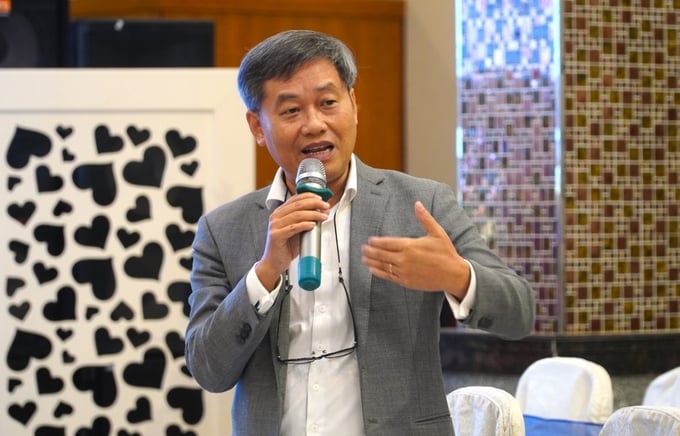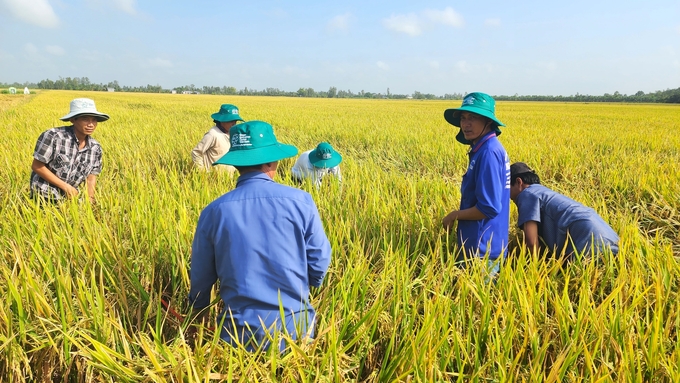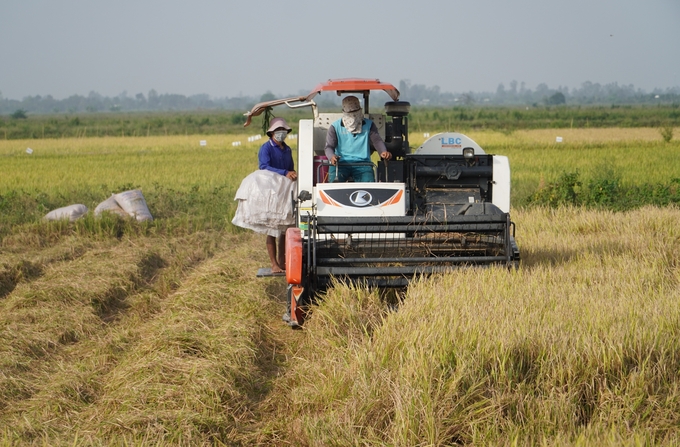November 27, 2025 | 03:53 GMT +7
November 27, 2025 | 03:53 GMT +7
Hotline: 0913.378.918
November 27, 2025 | 03:53 GMT +7
Hotline: 0913.378.918
Rice production is one of the industries responsible for greenhouse gas emissions. There are many reasons, such as unsustainable agricultural intensification, high rates of fertilizer application and water use for irrigation, and improper management of straws and husks.
It is time for Vietnam's agriculture to transform towards sustainability, especially in rice cultivation in the Mekong Delta. Vietnam Agriculture News recently had an interview with Cao Thang Binh, senior expert on agriculture of the World Bank (WB) in Vietnam to discuss this issue.

Cao Thang Binh, senior expert on agriculture of the World Bank in Vietnam. Photo: Kim Anh.
Facing the current green growth trend, what obstacles does Vietnam, especially the Mekong Delta, need to overcome to transform agriculture in a sustainable way, sir?
Over the past decade, Vietnam's rice industry has achieved many miracles. Vietnam's rice productivity is now among the highest in Southeast Asia, averaging 5.7 tons/ha. Recently, the quality of rice has also increased markedly, and Vietnam is one of the countries with the best rice in the world.
However, there are still a lot of things that Vietnam needs to do, which is to continue to increase income for farmers and reduce the environmental impact caused by rice production. Priority should be given to solving problems from now to 2030:
Reorganize production for farmers, train and improve the capacity of cooperatives, produce by applying sustainable farming production techniques, save input costs, reduce greenhouse gas emissions, create production and consumption chains;
Synchronously plan areas specializing in high-quality, low-emissions rice cultivation, invest in upgrading infrastructure specifically in-field irrigation systems;
Build a brand and develop a market for high-quality, low-emissions rice in the Mekong Delta and Vietnam in general, have policies to support enterprises in developing the market for high-quality, low-emissions rice;
Get access to international financial resources and support to develop a Measurement - Reporting - Verification (MRV) system as a basis for granting carbon credits to rice areas that have applied low-emissions rice production techniques, organize a team of staff to carry out the measurement and appraisal of carbon credits;
Promote circular economy, process and reuse rice straw, rice husk and bran;
Complete mechanisms and policies to encourage investment in the production of high-quality, low-emissions rice.

At least 1 million rice farmers in the Mekong Delta directly benefit from the Scheme of 1 million ha of high-quality rice. Photo: Kim Anh.
If the challenges you just mentioned are well resolved, what potential does the Mekong Delta hold when it comes to reducing greenhouse gas emissions?
From the research of WB and the results of the Agricultural Competitiveness Project (ACP) and the Vietnam Sustainable Agriculture Transformation Project (VnSAT) implemented by the Ministry of Agriculture and Rural Development (MARD) in the Mekong Delta provinces from 2012 to 2022, I believe the Mekong Delta has ample potential to reduce emissions in the rice value chain.
For example, applying sustainable rice production procedures “1 must 5 decreases” (1P5G) in the Scheme on 1 million ha of high-quality, low-emissions specialized rice can help reduce 4- 6 million tons of CO2e per year.
Processing and reusing rice straw to grow mushrooms and make fertilizer is also a promising approach. It is estimated that each year the Mekong Delta produces nearly 30 million tons of straw, if done well, these activities can reduce 1 - 2 million tons of CO2e per year.
Reducing post-harvest and rice processing losses from 12 - 13% to 7 - 8% can help reduce emissions by 0.5 - 1 million tons of CO2e per year.
Converting parts of the inefficient rice area (approximately 500,000 ha) to other high-value, low-emissions crops (forestry trees, perennial fruit trees, etc.) can reduce emissions by 2.5 - 3.5 million tons of CO2e per year.
If we can execute these activities simultaneously well, the Mekong Delta can reduce a total of 8 - 12 million tons of CO2e per year (10 million tons of CO2e on average) from the rice chain alone.
The MARD is going to submit the Sheme on Sustainable Development of 1 million ha of high-quality rice associated with green growth in the Mekong Delta to the Prime Minister for consideration and approval. If the scheme is approved, Vietnam would become a model country for low-emissions rice production. What do you expect from this scheme?
If this scheme is approved by the Prime Minister for investment and implementation, Vietnam will be one of the first countries to produce and export high-quality, low-emissions rice in the world. This is in line with the growing demand of high-end markets which require green, clean, eco-friendly products.
Vietnam will also be able to issue carbon credits to rice farmers, and paying carbon credits means farmers can have additional income. There will be at least 1 million farming households in the Mekong Delta directly benefiting from the scheme.

The Mekong Delta can potentially reduce 8 - 12 million tons of CO2e per year by applying low-emissions technical methods in rice cultivation. Photo: Kim Anh.
To support Vietnam in low-emissions rice cultivation, what are the commitments of the WB in terms of technology as well as finance?
From mid-2022 until now, the WB has provided technical support to the Ministry of Agriculture and Rural Development in the process of developing the scheme of 1 million ha of high-quality rice associated with green growth in the Mekong Delta. The WB also helps the MARD access the Transformative Carbon Asset Facility (TCAF) managed by the WB.
It is expected that the TCAF will approve 40 million USD to support the implementation of the scheme from 2024 to 2027, with the first priority given to areas that already have well-functioning irrigation infrastructure.
With the experience from the successful implementation of the VnSAT project, the World Bank and the International Finance Corporation (IFC) are also ready to commit to more long-term ODA loans so that the Mekong Delta can invest in areas lacking infrastructure or currently unable to apply advance irrigation techniques such as alternate wetting and drying (AWD).
These loans will also support enterprises to invest in modernizing and synchronizing the processing and logistics infrastructure of the rice supply chain, thereby expanding the market for Vietnam's low-emissions rice products.
Thank you, sir!
Translated by Samuel Pham
/2025/11/26/4909-2-154329_878.jpg)
(VAN) Pearl grouper farming in HDPE cages not only delivers economic efficiency but also contributes to protecting the environment, creating jobs, and promoting marine-based experiential tourism.

(VAN) The model of making a living under the forest canopy through the agroforestry system in Van Son commune, Bac Ninh province, is expected to generate an annual income of approximately VND 30 million/ha.

(VAN) Many enterprises in Can Tho are harnessing natural energy and reducing greenhouse gas emissions in their production processes, thereby contributing to the promotion of a sustainable green transition.
/2025/11/24/3536-2-112800_176.jpg)
(VAN) Dong Nai now has tens of thousands of hectares of forests certified for sustainable management, and this area will continue to be expanded in the coming period.

(VAN) Vinh Ha hamlet (Dai Xuyen commune, Hanoi) is shifting away from small-scale farming as households adopt bioscurity into their breeder chicken models.

(VAN) Heavy rains make aquatic species more vulnerable to disease. Proactive water management and high-tech systems help farmers prevent outbreaks and protect yields.

(VAN) Greenhouses are shifting production mindsets in Binh Lu commune, enabling farmers to ‘weather the sun and rain’ and secure stable vegetable harvests throughout the year.